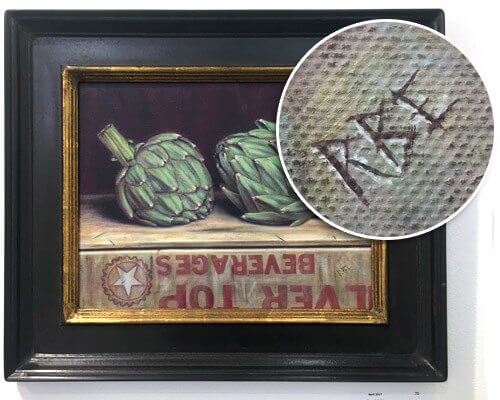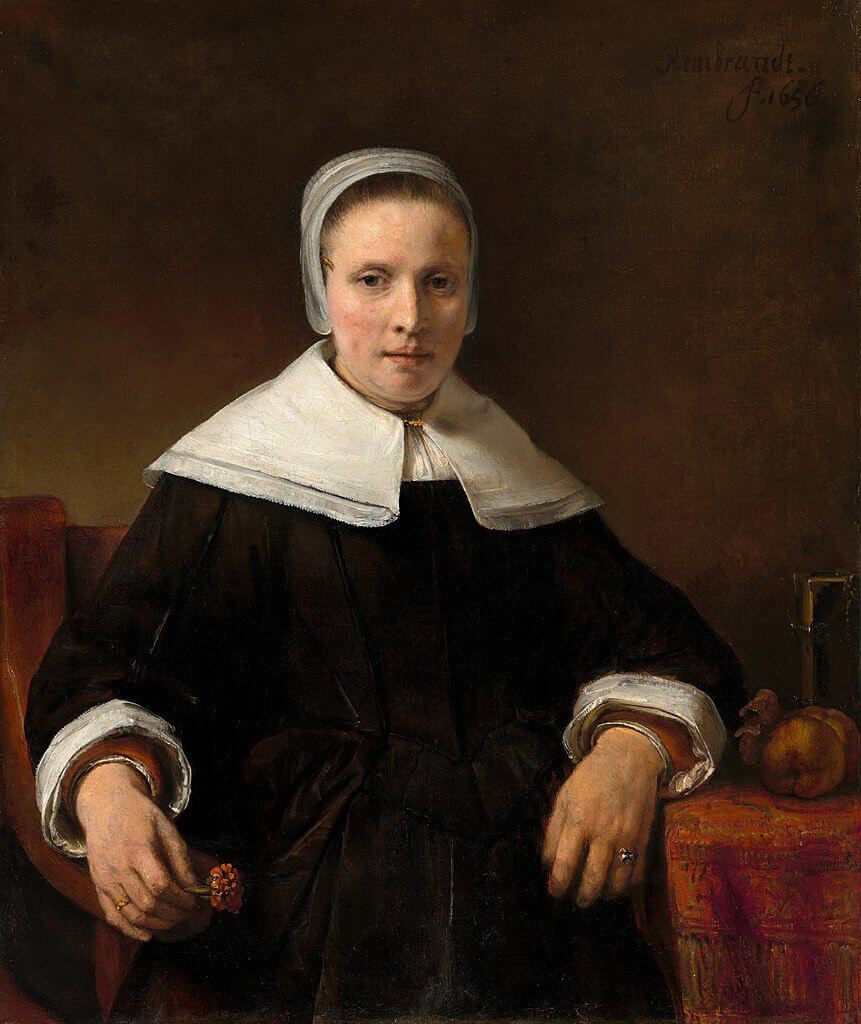How to Create an Artist's Signature and Sign Your Paintings

An artist's signature should be an extension of the artist. Here, Richard Ensing signs his painting in a bold red.
More...
An artist's signature is a calling card. Signing a painting claims ownership, gives additional value, and marks it as a complete, sellable piece.
However many artists struggle with signing their paintings. The addition of artist's signature can feel jarring to the painting if done incorrectly. Figuring out what your signature needs to be is an important part of establishing yourself as an artist.
A signature is meant to be a part of your painting. It ought to effortlessly complement the rest of the painting without drawing undue attention to itself. With thought and some practice, your signature can do just that and become a seamless addition to your paintings.
Your signature should feel like your work. It should feel like punctuation at the end of a thoughtful personal monologue.

“Artichokes on a Crate” by Brent Erickson, signed with the artist’s initials in a trompe l’oeil style, fitting in with the rest of the painting. (Courtesy of The Art League)
What and When to Sign
The first question an artist's signature must answer is the identity of the artist. When signing a painting it must be clear who has painted the piece. If you choose to sell your work, a signature is a business card, it tells people who created the painting. With that information, they can find your website or information to contact you.
Your artist's signature should be consistent. If you choose to sign with your first initial and last name, then have that be a harmonious part of your work. Changing the name on your paintings often will make it difficult to identify your work. A first name or initial and last name usually does the trick.
Once you’ve discovered what to sign, the next question is where and when should you sign it? Because a signature is an integrated piece of the painting, many artists sign as they work, rather than at the very end. This allows the signature to become a part of the painting. Signing at the end is a tried and true example, but will have a slightly less integrated feel to it, which works for many painting styles.

Rembrandt’s painting, “A woman Holding a Pink” (1656) shows his signature, signed in similar colors to the rest of the painting. (The National Gallery of Art)
Where to Sign
When choosing a place for an artist's signature, it is important to consider composition and your personal style. The signature is a part of the painting, so it must be balanced and in line with the rest of the piece. You may consider using the signature to balance out a compositionally uneven area in the painting. Or perhaps the signature will be hidden and integrated as a part of the painting, painted to look as though it were etched into bronze or carved into wood features.
Your signature is meant to be a part of your painting, so consider your style as you sign. If you produce elegant work, you must have an elegant signature that feels as though it comes from the same hand. Having a beautiful elegant painting and a signature scrolled across the middle in pure black won’t line up with the look and feel of your work.
As an artist, your work should be an extension of who you are, and your signature is a part of that work. Considering composition, style, and placement will help to explain who you are to your viewers.

Vincent Van Gogh’s signature is etched into the wet paint with the backside of the brush.
How to Sign
Many artists choose to sign their paintings with a small, round or flat brush. Add medium, so the paint flows freely, and the brushes are somewhat similar to a pen, depending on the substrate you choose to paint upon. Practicing to see how the paint reacts to your signature is a good idea. Taking the time to practice, but not obsessing over the action will yield a thoughtful, but natural, artist's signature.
The color of the signature depends on the painting. If you want the signature to stand out, perhaps you will choose a bold color in a red or a blue. But if the signature is meant to quietly compliment, you should choose a color that complements the overall colors of the painting.
If you are working with thick paint in puddling or an impasto technique, you may choose a different route for your signature. You may wait until the entire painting is dry. Or you may follow in the footsteps of artists like Vincent Van Gogh and scratch your signature into the wet paint with the wood end of the brush.

Evolve Head Instructor Piper Talladay’s signature is done in a small script, often placed in the foreground of the painting.
Conclusion
As you develop your artist's signature, remember that your signature and your work is an extension of who you are. So when you're trying to figure out what your signature should look like, take a look at your work. Is it harsh or jagged? Delicate or bold? Does it shout or is it a whisper?
Your signature should fall in line with your personality, and your personality should be seen in your work. The best way to find your artist's signature is to study your own work.


